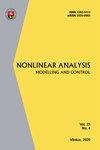考虑医疗资源影响的网络SIR模型的分岔分析与最优控制
IF 2
3区 数学
Q1 MATHEMATICS, APPLIED
引用次数: 0
摘要
提出了一种融合个人医疗资源因素和公共医疗资源因素的基于网络的SIR流行病模型。验证了公共医疗资源因子越大,控制繁殖数越小,个体医疗资源因子越大,可以减弱疾病的传播。我们发现控制繁殖数小于1不足以保证无病平衡点的全局渐近稳定。当医院床位数或个体医疗资源因子足够小时,系统将发生后向分叉。此外,还得到了最优控制和两个时变变量的最优解的存在唯一性。在无标度网络上,不同程度的最优控制水平也不同。最后,通过数值模拟对理论结果进行了验证。本研究表明,保持足够的公共医疗资源和个人医疗资源对于控制传染病至关重要。本文章由计算机程序翻译,如有差异,请以英文原文为准。
Bifurcation analysis and optimal control of a network-based SIR model with the impact of medical resources
A new network-based SIR epidemic model, which incorporates the individual medical resource factor and public medical resource factor is proposed. It is verified that the larger the public medical resource factor, the smaller the control reproduction number, and the larger individual medical resource factor can weaken the spread of diseases. We found that the control reproduction number below unity is not enough to ensure global asymptotic stability of the disease-free equilibrium. When the number of hospital beds or the individual medical resource factor is small enough, the system will undergoes backward bifurcation. Moreover, the existence and uniqueness of the optimal control and two time-varying variables’s optimal solutions are obtained. On the scale-free network, the level of optimal control is also proved to be different for different degrees. Finally, the theoretical results are illustrated by numerical simulations. This study suggests that maintaining sufficient both public medical resources and individual medical resources is crucial for the control of infectious diseases.
求助全文
通过发布文献求助,成功后即可免费获取论文全文。
去求助
来源期刊

Nonlinear Analysis-Modelling and Control
MATHEMATICS, APPLIED-MATHEMATICS, INTERDISCIPLINARY APPLICATIONS
CiteScore
3.80
自引率
10.00%
发文量
63
审稿时长
9.6 months
期刊介绍:
The scope of the journal is to provide a multidisciplinary forum for scientists, researchers and engineers involved in research and design of nonlinear processes and phenomena, including the nonlinear modelling of phenomena of the nature. The journal accepts contributions on nonlinear phenomena and processes in any field of science and technology.
The aims of the journal are: to provide a presentation of theoretical results and applications; to cover research results of multidisciplinary interest; to provide fast publishing of quality papers by extensive work of editors and referees; to provide an early access to the information by presenting the complete papers on Internet.
 求助内容:
求助内容: 应助结果提醒方式:
应助结果提醒方式:


